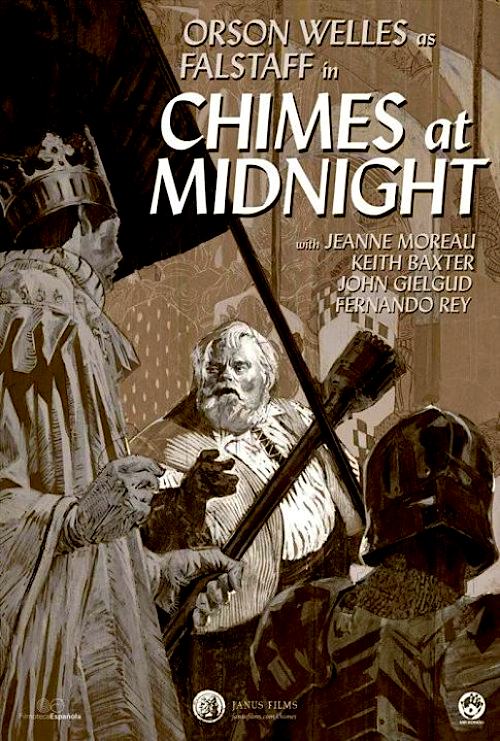By Joe Bendel. Orson Welles really made his reputation staging Shakespeare, particularly the “Voodoo Macbeth” produced for the Federal Theatre Project. Unfortunately, it was another Shakespearean production that perfectly symbolized the auteur’s mid-1960s fall from critical favor. In retrospect, it is rather embarrassing that The New York Times was more preoccupied with Welles’ girth than his artistic vision. It is worth remembering the next time the editorial page decides to give us a lecture on civility. Still, a lot of people missed the boat on Welles’ Falstaff and rights conflicts made it difficult for more appreciative later generations to catch up with it. Happily, Welles’ under-heralded Chimes at Midnight gets a special, restored DCP limited engagement, starting exclusively this Friday in New York at Film Forum.
Don’t hold your breath for St. Crispin’s Day. This is Falstaff’s story, not Prince Hal’s. Never shy about reworking Shakespeare, Welles basically plundered Falstaff’s greatest hits for the Henriad cycle, throwing in a few lines here and there from The Merry Wives of Winsor. However, the guts of the film come from Henry IV Parts 1 and 2, focusing on Prince Hal’s competing loyalties to two father figures, the hedonistic yet strangely gallant Sir John Falstaff and his severe father, Henry IV. Falstaff is way more fun, but the King represents his future.
Aware the Lancasters’ claim to the throne is iffy at best, the King would be much relieved to see Prince Hal start to take his duties more seriously. Instead, he prefers to carouse in bawdy houses with Falstaff and the more polished but just as disreputable Ned Poins. Unfortunately, his profligacy only encourages rebellion among the nobility, who have rallied behind the dashing and popular Sir Henry Percy, a.k.a. Harry Hotspur, as their champion. Prince Hal cuts a poor figure beside him.
 As for Falstaff’s figure, it is impressive, in its way. As the Times so brutally pointed out, you can’t spell Falstaff without an “f,” “a,” and “t.” Yet, there is more to Welles’ Sir John than the low comedy we associate with the reprobate. It is like he is a metaphor for Welles’ own career. Shticky on the outside, like the persona hosting Nostradamus documentaries and Paul Masson wine commercials, but he was heroic on the inside, like the director who labored for years to complete Don Quixote. Just like Falstaff, Welles was once the toast of Hollywood and a critical darling, but the establishment would turn against him in his later years, much like Prince Hal will inevitably renounce his friendship with Falstaff.
As for Falstaff’s figure, it is impressive, in its way. As the Times so brutally pointed out, you can’t spell Falstaff without an “f,” “a,” and “t.” Yet, there is more to Welles’ Sir John than the low comedy we associate with the reprobate. It is like he is a metaphor for Welles’ own career. Shticky on the outside, like the persona hosting Nostradamus documentaries and Paul Masson wine commercials, but he was heroic on the inside, like the director who labored for years to complete Don Quixote. Just like Falstaff, Welles was once the toast of Hollywood and a critical darling, but the establishment would turn against him in his later years, much like Prince Hal will inevitably renounce his friendship with Falstaff.
Whether Welles consciously identified with Falstaff on that level scarcely matters. It is still all there on the screen, in all its glorious pathos. Without question, Welles is the definitive Falstaff, puffed up with bluster, but achingly sensitive on the inside. His love for the Prince feels absolutely, painfully real.
Keith Baxter is also a minor revelation as Prince Hal. Probably better known for his stage work, Baxter is electric as the young prince. He might just be the coldest, most ruthless Prince Hal/Henry V seen on film, arguably bordering on the sociopathic. Yet, the great Sir John Gielgud might just upstage everyone, Welles included, as the ascetically noble and remorseful Henry IV. Even though most people automatically harken back to Arthur whenever his name is dropped, Chimes might be the best film to remember him by. Welles only had two weeks with Gielgud, but they made every second count. As a bonus, Jeanne Moreau also finds the earthy dignity in Dolly Tearsheet, Falstaff’s favorite “hostess.”
Chimes is a major Wellesian work that takes his signature visual flair to an even higher level. Every frame is a work of art, but the gritty grace and caustic wit of the ensemble performances remain incisive throughout. Wonderfully stylish and elegiac, Chimes at Midnight should be considered a worthy film in Welles’ canon. Very highly recommended, it opens New Year’s Day at Film Forum.
LFM GRADE: A+
Posted on December 31st, 2015 at 7:39pm.